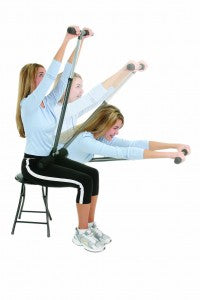FREE SHIPPING ON ORDERS OVER $25*
FREE SHIPPING ON ORDERS OVER $25*

Preventing Pain Before It Begins
Since pain occurs after the imbalances arrive, not before, relying on pain as the only indicator that your interconnective chain may be imbalanced or overstressed could lead you to a life of back problems. While statistically it is likely that you will suffer from back pain at some point in your life, taking preventative measures may help reduce the severity of the strain and positively impact recovery time.
 Keeping your posterior chain (calves, glutes, hamstrings and lower back) strong and flexible is one of the best things you can do to prevent back pain. Exercises that increase balance, flexibility and strength can decrease your risk of injuring your back, falling, or breaking bones. (5)
Keeping your posterior chain (calves, glutes, hamstrings and lower back) strong and flexible is one of the best things you can do to prevent back pain. Exercises that increase balance, flexibility and strength can decrease your risk of injuring your back, falling, or breaking bones. (5)
Long-Term Back Pain Relief
Any sufferer of back pain will tell you that their immediate objective is to reduce pain and restore mobility. While the natural tendency may be to rest, exercise may be the most effective way to speed recovery from low back pain. A Finnish study found that persons who continued their activities without bed rest following the onset of low back pain appeared to have better back flexibility than those who rested in bed for a week. (6)
Exercise, including stretching and strengthening of the muscles along the posterior chain (calves, glutes, hamstrings and lower back) has been shown to benefit many lower back pain sufferers by restoring muscle balance, strength and flexibility. 5, 7
A Medically Proven Solution
Originally developed for use by physical therapists, the CoreStretch was developed to provide the deepest, most effective way to stretch your posterior chain and restore muscle
flexibility and interaction, thereby, increasing range of motion, reducing pain, preventing further injury, and speeding up recovery. In fact, studies have shown the CoreStretch to be an effective way to stretch the hamstrings and contribute to posterior chain flexibility.
Unlike conventional stretching methods that force the back to curve, the unique design of the CoreStretch decompresses the back, enabling a deeper, more effective stretch of the posterior muscle chain supporting your back, spine, and legs.
The CoreStretch provides a stretch that both allows the tissues to relax and elongate developing the major muscle groups that make up the core. That’s why in therapeutic environments the CoreStretch is used to treat back, shoulder and hip pain, piriformis, fibromyalgia ,sciatica, arthritis and osteoporosis.
Most people find that just a few minutes of stretching every day with the CoreStretch reduces the pain associated with RMIs and improves quality of lifeis a light-weight and portable stretching device that takes the guesswork out of stretching your back muscles and relieves the pain associated with RMIs
Comprehensive
The CoreStretch provides the same instant decompression and relief you get with inversion tables by creating a natural, safe traction that you can control but goes beyond the immediate relief to become part of a more comprehensive program that delivers long-term repair. The three-plane swivel enables up-and-down, side-to-side, and twisting motions for the entire posterior chain — back, hips, hamstrings, shoulders and glutes. And with three levels of fitness and 10 sizing options, the CoreStretch provides the optimal stretching tool which can easily and effectively be used in seated, standing or floor positions.
Portable
Light-weight and collapsible, the CoreStretch can conveniently be taken to the office or job site to be used daily, even several times a day as a fast an effective way to break the repetition and combat RMIs.
For causes of back pain read Back Pain Relief: Part 1 – Causes
The post Back Pain Relief: Part 2 appeared first on Medi-Dyne.


